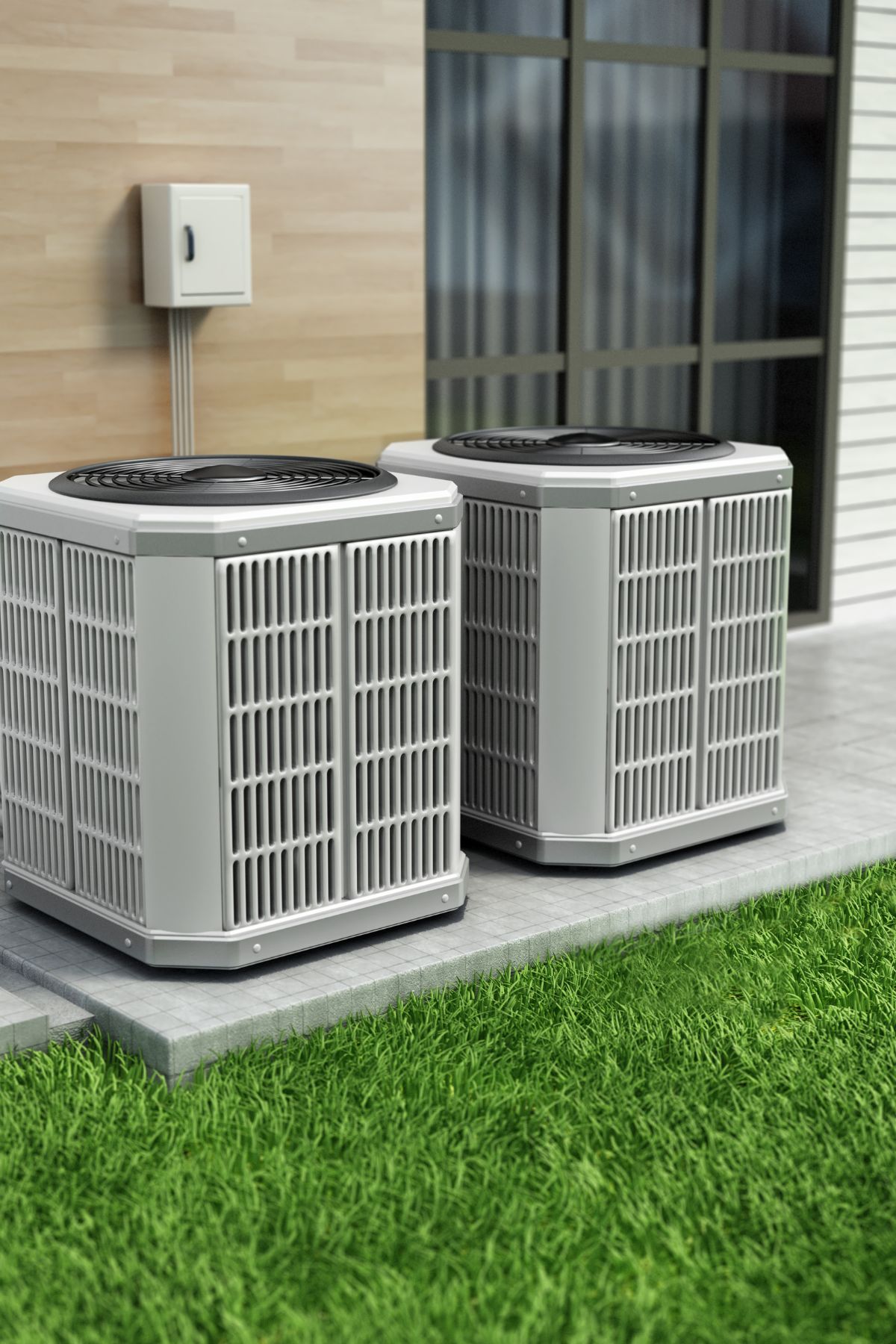This Heat Pump Sizing Calculator helps homeowners estimate the correct heating and cooling capacity for their homes based on factors like square footage, insulation, air leakage, and climate zone.
Heat Pump Sizing Calculator
| Tonnage | Approx. BTU/hr | Typical Home Size (sq ft) |
|---|---|---|
| 1.5 Ton | 18,000 | Up to 1,000 |
| 2 Ton | 24,000 | 1,000 – 1,400 |
| 2.5 Ton | 30,000 | 1,400 – 1,800 |
| 3 Ton | 36,000 | 1,800 – 2,100 |
| 3.5 Ton | 42,000 | 2,100 – 2,400 |
| 4 Ton | 48,000 | 2,400 – 2,700 |
| 5 Ton | 60,000 | 2,700 – 3,200+ |
About Air Infiltration: Air leakage can significantly affect heating and cooling requirements. This calculator estimates infiltration load using Q = 0.018 × Volume × ΔT × ACH, where ACH represents the number of complete air changes per hour in the building.
Choosing the right heat pump size is one of the most important decisions when upgrading or installing a new HVAC system. An accurately sized system ensures optimal comfort, energy efficiency, and longevity, while an oversized or undersized unit can lead to temperature swings, higher energy bills, and unnecessary wear.
Our calculator uses simplified engineering principles derived from Manual J standards to estimate your home’s heating and cooling load, giving you a realistic starting point before consulting an HVAC professional.
Why Proper Heat Pump Sizing Matters
Proper sizing isn’t just about comfort — it’s about performance and long-term savings. An undersized heat pump will struggle to maintain your desired indoor temperature during extreme weather, running continuously and consuming more energy. In contrast, an oversized system will heat or cool your home too quickly, causing frequent cycling that reduces efficiency and shortens the compressor’s lifespan.
When a heat pump is sized accurately, it runs at steady, moderate output. This consistent operation minimizes temperature fluctuations, reduces mechanical strain, and lowers your utility costs. A right-sized system also dehumidifies more effectively in summer, improving overall indoor air quality.

Factors That Affect Heat Pump Sizing
The total heating and cooling load of your home depends on several variables. Our Heat Pump Sizing Calculator accounts for the following key factors:
1. Home Area (Square Footage)
The starting point for any load estimate. Larger homes require higher BTU/hr output, but shape and layout also influence energy demand.
2. Climate Zone / Temperature Differential (ΔT)
Climate zones determine how much heating or cooling your home needs to offset outdoor temperatures. A colder climate zone (e.g., Zone 7) experiences a larger ΔT and therefore requires more capacity than a mild region.
3. Insulation Quality (R-Values)
Insulation acts as your home’s thermal barrier. The higher the R-value (e.g., R-30 for ceilings, R-15 for walls), the slower the rate of heat transfer. Better insulation lowers heating and cooling demands.
4. Window U-Factor
Windows are typically the weakest point in the building envelope. The U-factor measures how easily heat passes through them. Lower U-factors (around 0.30–0.35) indicate efficient double or triple-pane windows.
5. Ceiling Height & Volume
Heat rises, so taller ceilings increase the air volume that must be conditioned. Our calculator multiplies area by height to determine the total indoor volume.
6. Air Infiltration (ACH)
This often-overlooked factor measures how leaky your home is. Air Changes per Hour (ACH) quantifies how many times indoor air is replaced with outdoor air in an hour. Infiltration adds a significant load in both winter and summer.
The infiltration load is estimated using the engineering formula:
Qinf = 0.018 × Volume × ΔT × ACH
Where:
- 0.018 is a constant derived from air density and specific heat.
- Volume is the indoor space in cubic feet.
- ΔT is the indoor-outdoor temperature difference.
- ACH represents air leakage, typically 0.35 for tight homes and up to 1.5 for older ones.
7. Safety Margin
A small safety factor (around 10%) is added to ensure your system can handle unexpected temperature extremes or minor calculation errors.

How the Heat Pump Sizing Calculator Works
Our online calculator simplifies the principles used in professional Manual J software. It calculates total heat loss (in BTU/hr) by adding the effects of walls, windows, ceiling, floor, and air leakage.
You can choose between Simple Mode and Advanced Mode:
Simple Mode
Ideal for quick estimates based on home area and climate zone. It uses typical BTU-per-square-foot factors ranging from 25 (hot regions) to 60 (cold climates).
Advanced Mode
Adds detailed parameters such as insulation (R-value), window efficiency (U-factor), ceiling height, and air changes per hour (ACH).
It computes heat loss using these equations:
- Wall loss: Qwall = ( Awall × ΔT ) / Rwall
- Window loss: Qwindow = Awindow × Uwindow × ΔT
- Ceiling & floor loss: Q = ( A×ΔT ) / R
- Air infiltration: Qinf = 0.018×Volume×ΔT×ACHQ_{\text{inf}} = 0.018 \times \text{Volume} \times \Delta T \times \text{ACH}Qinf=0.018×Volume×ΔT×ACH
Finally, all these components are summed and increased by 10% for safety. The calculator then converts total BTU/hr into tons (1 ton = 12,000 BTU/hr).
Users can also check an “Include Cooling Estimate” box to estimate cooling loads based on area and window contribution — useful for year-round planning.
Understanding the Results
When you click Calculate, the Heat Pump Sizing Calculator provides two main results:
- Estimated Heating Load (BTU/hr)
This represents the total amount of heat your pump must deliver to maintain indoor temperature during the coldest design day. - Recommended Heat Pump Size (Tons)
The tool divides the total BTU/hr by 12,000 to convert it into tons, the standard measure for HVAC capacity.
Example:
If your calculated load is 36,000 BTU/hr →
36,000 / 12,000 = 3.0 tons
Your recommended heat pump capacity would be 3 tons.
The calculator also includes a handy reference table so users can quickly cross-check:
| Tonnage | Approx. BTU/hr | Typical Home Size (sq ft) |
|---|---|---|
| 1.5 Ton | 18,000 | Up to 1,000 |
| 2 Ton | 24,000 | 1,000–1,400 |
| 2.5 Ton | 30,000 | 1,400–1,800 |
| 3 Ton | 36,000 | 1,800–2,100 |
| 3.5 Ton | 42,000 | 2,100–2,400 |
| 4 Ton | 48,000 | 2,400–2,700 |
| 5 Ton | 60,000 | 2,700–3,200+ |
This helps homeowners interpret their results and compare them to typical residential system sizes.
Typical Sizing Recommendations
Although every home is unique, these general rules of thumb can guide expectations:
| Climate Zone | Home Size | Approx. Heat Pump Size |
|---|---|---|
| Hot / Humid (Zone 1–2) | 1,500–2,000 sq ft | 2.5 – 3 tons |
| Moderate (Zone 3–5) | 1,500–2,000 sq ft | 3 – 3.5 tons |
| Cold / Northern (Zone 6–7) | 1,500–2,000 sq ft | 3.5 – 4 tons |
Remember, better insulation or air sealing can significantly reduce these requirements. Even a moderate improvement in ACH (from 1.5 to 0.7) can lower heating load by several thousand BTU/hr.

Conclusion
Sizing a heat pump correctly is essential for year-round comfort, energy efficiency, and long equipment life. The Heat Pump Sizing Calculator provides a reliable first estimate using your home’s dimensions, insulation, and climate data.
By including advanced factors such as R-values, window efficiency, ceiling height, and air infiltration, this calculator gives a realistic, physics-based estimate of your home’s heating and cooling needs.
Use the results as a guide when discussing system options with your HVAC professional — and remember that improving insulation or sealing air leaks can often let you install a smaller, more efficient system.
